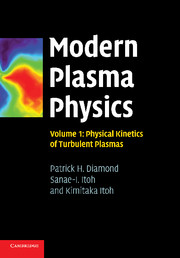Book contents
- Frontmatter
- Contents
- Preface
- Acknowledgements
- 1 Introduction
- 2 Conceptual foundations
- 3 Quasi-linear theory
- 4 Nonlinear wave–particle interaction
- 5 Kinetics of nonlinear wave–wave interaction
- 6 Closure theory
- 7 Disparate scale interactions
- 8 Cascades, structures and transport in phase space turbulence
- 9 MHD turbulence
- Appendix 1 Charney–Hasegawa–Mima equation
- Appendix 2 Nomenclature
- References
- Index
7 - Disparate scale interactions
Published online by Cambridge University Press: 05 October 2010
- Frontmatter
- Contents
- Preface
- Acknowledgements
- 1 Introduction
- 2 Conceptual foundations
- 3 Quasi-linear theory
- 4 Nonlinear wave–particle interaction
- 5 Kinetics of nonlinear wave–wave interaction
- 6 Closure theory
- 7 Disparate scale interactions
- 8 Cascades, structures and transport in phase space turbulence
- 9 MHD turbulence
- Appendix 1 Charney–Hasegawa–Mima equation
- Appendix 2 Nomenclature
- References
- Index
Summary
Long and short delimit each other.
(Lao Tzu, “Tao Te Ching”)Short overview
In this chapter, we describe one generic class of nonlinear interaction in plasmas, called disparate scale interaction. One of the characteristic features of plasma turbulence is that there can be several explicit distinct scale lengths in the dynamics. For example, the ion gyroradius and electron gyroradius define intrinsic lengths in magnetized plasmas. The Debye length λDe = νT,e/ωpe gives the boundary for collective oscillation, and the collisionless skin depth, c/ωpe, is the scale of magnetic perturbation screening. These characteristic scale lengths define related modes in plasmas.
One evident reason why these scales are disparate is that the electron mass and ion mass differ substantially. Thus the fluctuations at different scale lengths can have different properties (in the dispersion, eigenvectors, etc.). Such a separation is not limited to linear dispersion, but occurs even in nonlinear dynamics. This is because the unstable modes are coupled with stable modes within the same group of fluctuations (those with a common scale length). The plasma response often leads to the result that instability is possible for a particular class of wave numbers. For instance, the drift waves in magnetized plasma (which preferentially propagate in the direction of diamagnetic drift velocity) can be unstable only if the wave number in the direction of the magnetic field k∥ is much smaller than that in the direction of propagation.
- Type
- Chapter
- Information
- Modern Plasma Physics , pp. 266 - 298Publisher: Cambridge University PressPrint publication year: 2010



